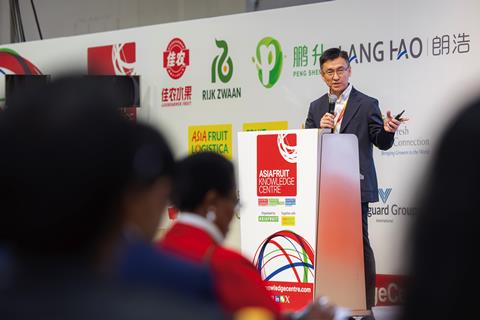Digital transformation and a growing middle class have led to major consumer behaviour shifts, opening new retail and marketing channels for fresh produce marketers
Indonesia continues to hold significant untapped market potential for the global fresh produce industry. With increased urbanisation, an expanding middle class and a more health-conscious younger demographic, the appetite for imported fruit is growing – as are the pathways for marketing to consumers.

These were some of the main takeaways from Yuyuh Sukmana’s presentation on the country at Asiafruit Congress in September.
As part of the presentation, Sukmana, who is regional manager - South-East Asia for Vanguard Group International, shared a market overview spotlighting Indonesia’s significant change in recent years.
“If you look back to 2018 only 50 per cent of the population had internet access,” he said. “But then the pandemic pushed the government to expand the network, and according to the latest report from Indonesian Internet Providers Association, today there are over 220mn internet users in Indonesia, and that’s about 81 per cent of the population.”
Alongside this digital transformation, Indonesia’s cities have also been developing.
“Historically, Indonesia’s economic development was much more concentrated in Java Island,” Sukmana explained. “However, the improvement in infrastructure and inter-island logistics are driving the economic growth in those regions, especially in the eastern part of the country.”
This has opened up more markets within the country, both online and in cities outside of Java.
Fruit imports
“We are seeing imported fruit reaching more regions now,” Sukmana said.
The vast majority of imported fruit falls into five main categories – apples, pears, grapes, mandarins and longan – with China the leading supplier for all except for the longan which mostly comes from Thailand.
According to Sukmana, China held a 96 per cent share of pear imports last year, a slight increase from the five-year average of 95 per cent. For apples, China’s share grew from the five-year-average of 86 per cent to 89 per cent last year, grapes from the 68 per cent average to 72 per cent last year, and mandarins grew from an average of 71 per cent to 78 per cent last year.
“This shows not only China’s pricing power, but also its ability to keep offering new varieties, improve quality and extend their seasonality through the expansion of their growing areas,” Sukmana explained.
Indonesia has also seen rapid growth in the imports of blueberries and cherries thanks in part to China offering more affordable options.
Retail landscape
“When it comes to fresh produce, the main consumers [in Indonesia] are the middle to upper class, which make up around 18 per cent or 50mn people,” Sukmana explained.
“They are mainly the Gen X, the Millennials and the Gen Z, and these groups have a higher awareness of health, physical wellness, quality, convenience and also time saving solutions.”
Because of this shift, shopping habits in Indonesia have changed from a monthly bulk buy to more frequent weekly or even daily trips.
“We are seeing a decline in larger formats like the hypermarkets, including closures of more international chains in the recent years,” Sukmana said.
“While convenience stores continue to grow.”
Interestingly, Sukmana said that traditional markets which have long dominated the shopping landscape have managed to sustain their presence despite expectations they would lose ground to more modern retail.
“[This has happened] through overall improvement in shopping experience, supported mainly by local government but also the private developers,” he said. “Now when developers build new housing complexes, traditional or fresh market will be one of the facilities they will include.”

Market challenges
Despite the many opportunities for fresh produce marketers in Indonesia, the market is not without its challenges. The most significant is the government’s complex import system of permits and quotas.
“It’s very difficult for the industry to measure the real consumer demand in this market because the volume going into Indonesia is very much influenced by quota controlled by the authority,” Sukmana said.
“[Just because pears are the largest import by volume] it doesn’t mean that pears are the food with the highest demand. It’s mainly because it’s a non-quota product, so there’s no volume restriction.”
This article appears in the upcoming eition of Asiafruit Magazine. For more coverage from the Asiafruit Knowledge Centre visit the Asiafruit App.



